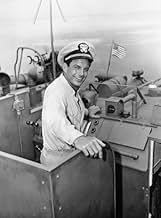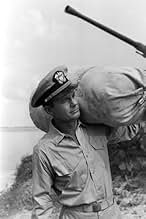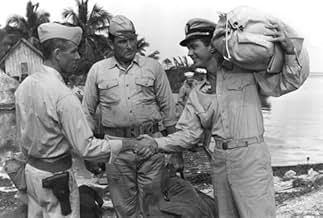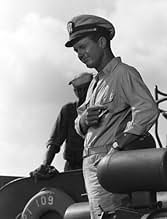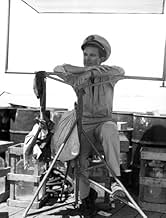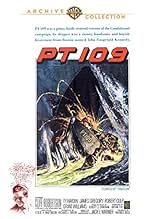Ajouter une intrigue dans votre languePresident John F. Kennedy kept a unique inauguration gift on his desk: a plastic-encased coconut. The tale of that coconut is the heroic story of PT 109.President John F. Kennedy kept a unique inauguration gift on his desk: a plastic-encased coconut. The tale of that coconut is the heroic story of PT 109.President John F. Kennedy kept a unique inauguration gift on his desk: a plastic-encased coconut. The tale of that coconut is the heroic story of PT 109.
- Réalisation
- Scénario
- Casting principal
- Edgar E. Mauer
- (as Biff Elliott)
- Harold Marney
- (as Evan McCord)
- Andrew Kirksey
- (as Sammy Reese)
Avis à la une
Probably Cliff Robertson wisely decided not to try for a Boston accent in his portrayal of the 35th president of the United States during his World War II years. If he had he might have come off as imitating Vaughn Meader imitating John F. Kennedy. As it is the only concession he made to the role was a bit of reddish tint in his hair to suggest the man he was playing. It worked rather well and still works today.
Ironically though had their been other U.S. Navy craft near the PT 109 when the Japanese battleship Amagiri sliced it like a loaf of bread in the middle of the night who could have picked up survivors, Lieutenant j.g. John F. Kennedy probably would have been facing a court martial for losing his boat that way. It was the only PT boat in World War II lost to the Japanese in that manner.
But the story is not about that as it was the survival of all, but two of his crew who were killed in the collision. It's about Lieutenant Kennedy towing an injured man while swimming for a deserted Pacific island and keeping his men alive until they could be rescued. The Navy was not about to court martial a hero.
Warner Brothers filled out the rest of the cast with some tried and true players, some like Ty Hardin and Grant Williams from their television series which was rapidly taking over the Warner Brothers lot. Particularly I liked James Gregory as the career naval officer in charge of the PT squadron and Michael Pate as Australian coast watcher Reg Evans. This is one of the few American made films where Michael Pate plays someone from his own country.
I remember on Jack Paar's Friday night variety show he devoted an entire hour to one long commercial for this film. He reunited all of the surviving PT 109 survivors with Australian coast watcher Reg Evans who had a big hand in rescuing them. Evans had met Kennedy of course, but had never met the rest of the crew. The whole living crew was there except the skipper who was in the White House and who could know he'd be the next one to die.
If JFK had lived and been running for re-election in 1964 what a great piece of election propaganda PT 109 would have been. The story also had a lot to do with his successful campaign in 1960. Kennedy was running under the cloud of his father Joseph P. Kennedy being a supporter of appeasement back in the day. This story and the death of his older brother Joseph P. Kennedy, Jr. in combat in the European theater blunted a lot of the criticism of the actions of his father.
PT 109 is a nicely done war film and a great piece of nostalgia for the Kennedy years.
PT 109 is a respectful movie of a Naval Hero.
David Barra Los Angeles
The best performance in the film is delivered by JAMES GREGORY as the hard-nosed commander of the PT squadron, with a cynical view of the young Kennedy who has had no wartime training until he arrives in the Pacific to put together a crew to work aboard a hastily repaired patrol boat.
It's a story of courage and heroism that could have been told in ninety minutes to make the drama more taut. Instead, the film is padded out to a two-hours and twenty-minutes length that makes it feel like another "Mr. Roberts," especially during the long first hour.
All of the squadron members are well played by a cast that includes TY HARDIN, GRANT WILLIAMS and ROBERT BLAKE as able seamen who form Kennedy's crew. Touches of wartime humor are present with amusing lines throughout. ("The skipper would mount a tank on a PT boat if he could find one," says a loyal crewman at one point). And when Kennedy is reminded of how idealistic he is when confronting the most unfavorable situations, he replies with a grin: "It must be a character flaw."
The only real flaw with the film is its length, which robs it of some much needed tension toward the middle. However, as a film examining the earlier life of JFK's participation as a lieutenant in WWII, it's satisfying enough as a realistic depiction of the events aboard PT 109.
Summing up: The basic story of Kennedy's efforts to bring his men back safely from a dangerous mission is effectively portrayed and manages to hold the interest despite being overlong. Worth seeing at least once.
The 60s and 70s would have been so much better for everyone if JFK had 8 years in the White House.
In the big scheme of World War II, the events depicted here would have been forgotten except that the central heroic figure, John F. Kennedy, would later become U.S. President. For those of us who lived through the Kennedy years, this portrait of JFK in his 20's is quite consistent with the JFK we later saw when he became nationally prominent and subsequently president. (If "Private Ryan" deserves a movie, then JFK and his shipmates are surely no less entitled.)
The story begins when JFK arrives in the Pacific and is given command of a PT ("Patrol Torpedo") boat. PT boats were fast wooden craft with a crew of 12 and carried four torpedos and some small-bore guns, capable of quickly getting in and out while operating in shallow waters and doing various odd jobs on short notice. Without a lucky torpedo shot, any one boat was not going to be noticed by history.
PT 109 operated into an area of Pacific waters and small islands mainly controlled by the Japanese. One of Kennedy's first missions was to provide covering fire onto shore and extricate some stranded Americans. The boat remained under enemy fire until the rescue was complete, notwithstanding casualties both to crew and those rescued.
On PT 109's final mission, during darkness and limited visibility (radar was not yet on most PT boats), a Japanese destroyer, perhaps unwittingly, slices through PT 109, half of which sinks while the other half capsizes, but not before JFK and surviving crew members make an arduous swim to shore, taking along their wounded---and shoes. Aerial reconnaissance later sights the wreckage and reports "no survivors."
How the PT 109 crew is finally saved results partly from good luck and partly from daring, ingenuity, exhausting swims, and a refusal to give up. Yes, this is also a feel-good movie!
(The movie also acknowledges the part played and risks taken by "coast watchers," isolated individuals who infiltrated islands in Japanese-controlled areas, maintained lookouts from high ground, and radioed back critical information on enemy movements.)
Le saviez-vous
- AnecdotesCliff Robertson portrays John F. Kennedy during his late-20s during World War II; Robertson was 40 years old when this film was released.
- GaffesAlthough it is true that African-American sailors served as mess stewards and stevedores during the war, this did not necessarily exclude these sailors from assignment to a gun crew during general quarters aboard ship or ashore, or manning the guns when the assigned crew were killed or wounded. In those days, all sailors, regardless of rate, received basic gunnery training in boot camp.
- Citations
Ens. Leonard J. Thom: [reporting aboard the PT109] Mr. Kennedy? Ensign Leonard Thom, your exec.
[they exchange salutes]
Lt. John F. Kennedy: Oh, hi. Glad to meet you, Leonard.
[they shake hands]
Lt. John F. Kennedy: Welcome aboard.
Ens. Leonard J. Thom: [looking around the boat] How long did they give you to put it in shape?
Lt. John F. Kennedy: Well, we've used about half the time just talking right here.
- ConnexionsFeatured in 18th Annual Screen Actors Guild Awards (2012)
- Bandes originales99 Bottles of Beer
(uncredited)
Traditional
Meilleurs choix
Détails
Box-office
- Budget
- 4 000 000 $US (estimé)
- Durée2 heures 20 minutes
- Rapport de forme
- 2.35 : 1
Contribuer à cette page



